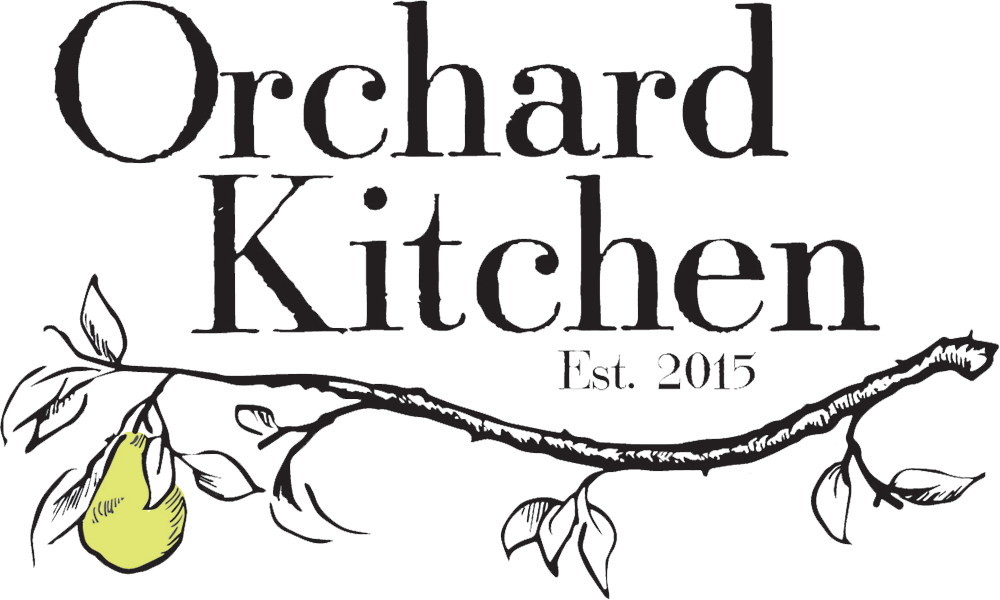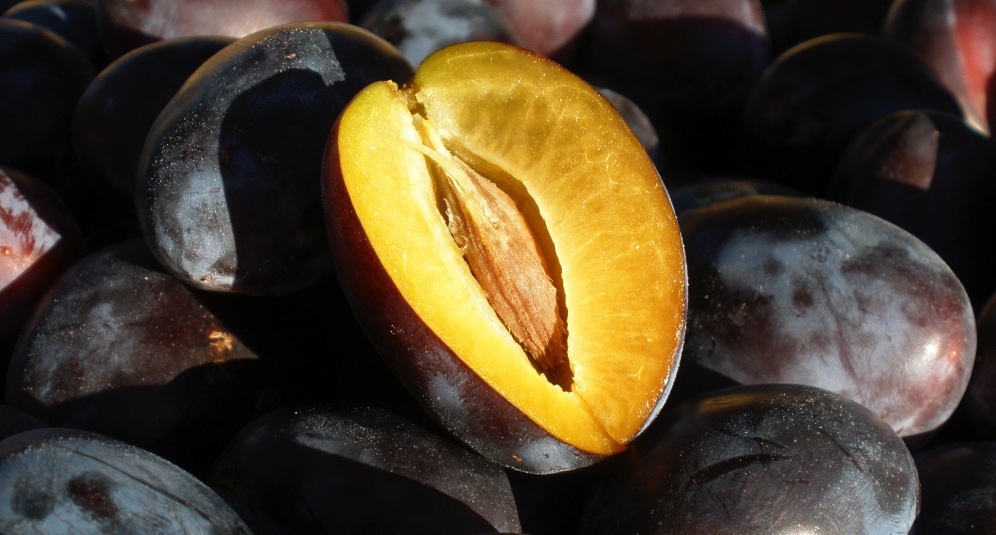How is a Plum like an Onion?
"No matter what produce you are working with, the variety you choose must match your intended application."
The humble Italian Prune Plum has probably been on Whidbey Island for over a century. There is nothing better for baking and preserving and they are happening right now.
If I am going to eat a fresh plum, then a Santa Rosa Plum, with its super fragile, water-balloon-like flesh is my hands down favorite. But when it comes to making jam, jelly or a plum tart, they cannot hold a candle to the much less sexy but ever more versatile Italian Prune Plum. Here is what you can do with them.
No matter what produce you are working with, the variety you choose must match your intended application. I first realized the beauty of Paste Tomatoes when I tried to make tomato sauce with slicing tomatoes. I had been given five cases of really ripe heirloom tomatoes from my friend Mark, my go-to tomato farmer in Napa. What he gave me was a mixture of medium sized red heirlooms. They were super ripe, and as such, they did not look good enough to sell at the Farmers' Market. They were very juicy and delicious, and I could not argue with the price.
Unfortunately, when I tried to turn them into sauce, they were completely wrong for the job.
There was so much water in them that the sauce had to be cooked down and down to about a quarter of its original volume. Even then it produced a rather thin, sweet, insipid sauce. Not my best work.
This kind of super ripe tomato is still what I prefer when making tomato water, and I used to request them in that over ripe state specifically for that purpose. If you have ever had the divine privilege of cutting a very ripe Hillbilly, Brandywine, or other heirloom slicing tomato, then you know why: The clear, sweet juice inside them just cannot be contained. Slice them and they will slowly bleed out clear, delicious tomato water all over your cutting board and your plate. If you cut a ripe paste tomato, the contrast could not be much more obvious. They seem downright dehydrated by comparison. They are nowhere near as juic-a-rific as slicers, but they are just the thing for sauce. They have plenty of sugar, but thicker, fleshier pulp so you do not have to cook them down for hours to get a delicious sauce. In their own way, they are a thing of beauty.
Those Santa Rosa Plums I mentioned earlier—or any of their delicious, juicy friends—are the slicing tomatoes of the fruit world.
They are mostly water. There is sugar in them but, like many fruits and vegetables, our perception of just how much sugar they have gets distorted. By that I mean that because their flavor is so clean, transparent and light, all we taste is the sugar. Their flesh is tender and unobtrusive. There is nothing to get in the way of our perceiving the sweetness. They are not, however, that high in sugar when you consider total dry extract sugar—what you would get if you took out all the water—or even in terms of sugar per total unit of weight.
The best example of this difference between total sugar concentration and perception of sweetness is, believe it or not, the onion.
This might sound odd, but we only perceive Walla Walla Sweet or Vidalia onions as being sweeter than plain old Spanish onions. That's because while plain, yellow onions have more sugar, sweet onions like Walla Wallas have a lot less sulfur and a lot higher water content. Because "sweet" onions do not have the sulfur to make our eyes water and skew our perception, they seem a lot sweeter to us. What they are is a lot milder than a Spanish onion, but Spanish onions actually have more sugar, pound for pound. Try it yourself: Cook down ten pounds of each in two different pots and you will see the difference. The Spanish onions will yield a thick, sticky-sweet, caramelized onion jam, while the sweet onions do not amount to much at all, and what there is will have almost no texture to speak of.
Plum Crumb Tart
Getting back to our friend, the Italian Plum, they are the paste tomato of the plum world.
They have lots of flavor, the skins are packed with color to make your jams, jellies or tarts bright and pretty, and they have enough pulp to amount to something when you cook them. While they are tasty but not spectacular to eat out of hand, Italian plums blow the doors off of sweet, eating plums and Pluots when it comes to cooking.
So grab your ladder and go knock on your neighbor's door, (the one with the accumulation of molding plums falling all over their back lawn) and see if they would not mind sharing some of their bounty.
Here are a couple of recipes for Italian Plums that I have been playing with recently. I hope you enjoy them.
Plum Orane Marmadal
Plum Orange Marmalade
Ingredients
5 Cups Plum Juice
7 Cups Sugar
1 Pack Pectin
1 Orange, just the very thinly sliced jest, about 3 Tbls.
1/4 tsp Salt
Technique
Make the plum juice by putting seven or eight pounds of pitted plums, along with about a cup of water in a think bottom pot and bringing them to a boil. Cook them about 20 minutes, until very soft and thoroughly cooked, then strain them through a jam bag, muslin, or several layers of cheese clothe to make a clear, purple plum juice. Put the plum juice in a thick bottom pan and bring to a simmer. Put the sugar in a pan in a 250 degree oven to warm it up. Add the pectin and cook until dissolved. Add the sugar and stir until dissolved. Bring the mixture to a rolling boil and cook 3 minutes, no more. Remove from heat. Skim off the scum. Pour into jam jars and process as directed on the canning instructions. (I process mine in a boiling water processor for 10 minutes.)
Ginger Scented Plum Crumb Tart
This is a recipe I came up with several years back. I love the hint of ginger and lemon zest in that makes a nice counterpoint to the sweetness of the tart shell and crisp topping. Enjoy it warm with vanilla ice cream. The two base recipes for the tart dough and the crisp topping are both real winners and are incredibly versatile, so use them for other applications as well.
Ingredients for 10 small 4" tartlets or one 9" tart
For the Almond Shortbread Crust
1/2 Cup Sugar
1/2 Cup Ground almonds
6 ounces Butter, softened
1 Egg yolk
1 pinch Salt
1/4 tsp. Bitter almond or vanilla extract
2 Cups All-purpose flour
For the Crisp Topping
8 ounces Butter
1 Cup All-purpose flour
1 Cup Sugar
1 large pinch Salt
For the Plums
10 each Italian Prune Plum
2 tsp. Ginger juice (grate the ginger, then squeeze out the juice)
1/2 tsp. Finely-grated lemon zest
1 Tbls. Sugar
1 small pinch Salt
Technique
For the tart dough, combine the butter, almonds, sugar and egg yolk in a standing mixer and cream together well. When light and fluffy, add the extract and then, while beating at low speed, add the flour. Scrap the sides and combine well. This dough is pretty much bullet proof, so do not worry about over mixing. For the small tart shells, I like to fill them with my hands, using my thumbs to push the dough into the shell. You can, however, roll it out between sheets of wax paper or plastic wrap, then cut 6" rounds and push them into the shells if you prefer. Once the tarts are filled, freeze them for 20 minutes before baking.
For the crisp topping, simply combine all of the ingredients with you hands until it forms a uniform, crumbly mass. Break it into chunks of the desired size, depending on the application and your preference. The wetter the thing you are topping, the bigger the chunks should be and the more topping you will need.
Preheat you oven to 375 degrees. Slice the plums in half, and then the halves into three wedges. Toss with the ginger, lemon, sugar and salt. Sprinkle a little of the crisp topping into the bottoms of the tart shells. Fan the wedges of plum on top of the crisp topping, then dust the center of each tart with a little more crumbled crisp topping. Bake approximately 25 minutes, until the crust and crisp topping are golden and the plums are bubbly.
All recipes are original recipes of Vincent Nattress, All Rights Reserved.



